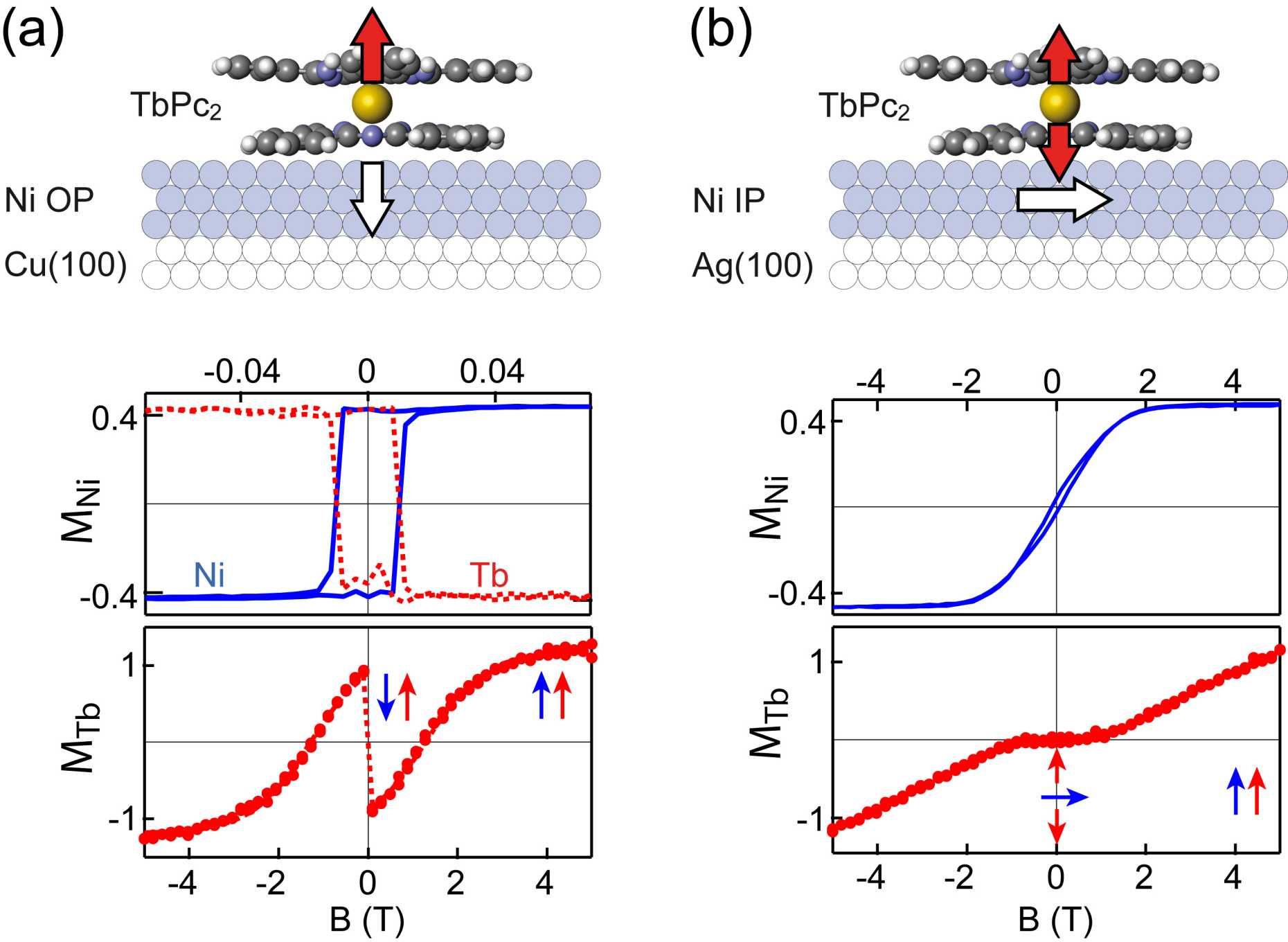Coupling of single molecule magnets to ferromagnetic substrates
TbPc2 single molecule magnets coupled to ferromagnetic Ni films with (a) out-of-plane and (b) in-plane easy magnetization axis. The plots show element-resolved out-of-plane magnetization loops of Ni (blue) and Tb (red) obtained by x-ray magnetic circular dichroism measurements. The arrows indicate the relative orientation of the molecule and substrate magnetic moments.
Conventional magnets rely on the collective behavior of the unpaired electron spins of millions of atoms. Single molecule magnets (SMM), on the other hand, may contain just one spin center enclosed by an organic cage, such as is the case of the bis-phthalocyaninato terbium complex (TbPc2). Because they are so small and identical with one another, single molecule magnets are ideal candidates for both magnetic data storage and quantum computing applications. Yet, despite intense research efforts, their usefulness to fabricate molecular memories is severely limited by two factors. First, SMM display remanent magnetization only at very low temperature. Second, interfacing SMM with solid state systems (electrodes, metal surfaces, etc.) has proven far from trivial.
We thus examine how SMM interact with ferromagnetic [1,2] and antiferromagnetic [2,3] films, which is a prerequisite to embed such molecules into hybrid metal-organic architectures and fabricate, for example, a molecular spin valve device. We focused on single, double, and triple-decker metal-phthalocyanine complexes owing to their compact structure, which constitutes an advantage to establish an exchange-coupling path between the magnetic core of the molecule (the central metal atom) and the underlying magnetic film (see Figure 1). In this example, Ni films were deposited on Cu(100) and Ag(100) single crystals provided substrates with either out-of-plane or in-plane easy magnetization, a parameter that can be controlled through epitaxial strain without changing the chemical composition of the interface [1].
By performing element-resolved magnetization measurements using x-ray magnetic circular dichroism (XMCD) at the ESRF, we proved that the magnetic moment of TbPc2 deposited on Ni is coupled antiparallel, that is, antiferromagnetic, to that of the Ni substrate. If the easy magnetization axis of TbPc2, which is out-of-plane, coincides with that of the Ni film, the magnetic moment o the molecule is effectively stabilized by the interaction with the substrate, resulting in a square magnetization hysteresis curve with nearly saturated magnetic remanence at zero applied field. (Figure 1a). Finite magnetic remanence persists up to 100 K, a temperature that is two orders of magnitude higher compared to isolated TbPc2. Depending on the strength of the applied magnetic field, we observe that both antiparallel and parallel magnetic configurations can be reached, as the Zeeman interaction compensates and eventually overcomes the exchange coupling between Tb and Ni. Moreover, if the easy magnetization axis of the Ni film is orthogonal to that of TbPc2, we observe pronounced frustration effects as the molecule magnetization cannot align with the substrate at equilibrium, and exhibits zero remanence at zero field (Figure 1b).
The detailed mechanism mediating the coupling between Tb and Ni atoms remains to be clarified. Given that Tb and Ni are physically separated by a Pc ligand, our data point towards an indirect exchange mechanism mediated by electrons hopping back and forth between the Pc macrocycle and Tb on one side and Ni on the other (Tb-Pc-Ni superexchange). We find that the strength of the molecule-substrate coupling can be tuned by electron or hole doping of the interface [1], which is expected to change the occupation of the Pc electron orbitals. This behavior also shows how the interface chemistry and magnetic response are intimately related in such systems.
These results demonstrate that SMM behave as coupled but separate magnetic units from an underlying ferromagnetic substrate. The enhanced thermal stability of the TbPc2 magnetic moment and the possibility to orient it parallel or antiparallel to a macroscopic ferromagnetic layer make this complex very interesting for applications in metal-organic magnetoelectronic devices. Further experiments taking advantage of the element-resolving power of x-rays may address the coupling of different families of SMM to magnetic layers, and extend it to more complex multilayer structures.
Selected publications
- [1] Coupling single molecule magnets to ferromagnetic substrates, A. Lodi Rizzini, C. Krull, T. Balashov, J.J. Kavich, A. Mugarza, P.S. Miedema, P.K. Thakur, V. Sessi, S. Klyatskaya, M. Ruben, S. Stepanow, and P. Gambardella, Phys. Rev. Lett. 107, 177205 (2011). Download article (PDF, 832 KB)
- [2] Coupling of single, double, and triple-decker metal-phthalocyanine complexes to ferromagnetic and antiferromagnetic substrates, A. Lodi Rizzini, C. Krull, A. Mugarza, T. Balashov, C. Nistor, R. Piquerel, S. Klyatskaya, M. Ruben, P. M. Sheverdyaeva, P. Moras, C. Carbone, C. Stamm, P. S. Miedema, P. K. Thakur, V. Sessi, M. Soares, F. Yakhou-Harris, J. C. Cezar, S. Stepanow, and P. Gambardella, Surf. Sci. 630, 316 (2014). Download article (PDF, 2.2 MB)
- [3] Exchange biasing single molecule magnets: coupling of TbPc2 to antiferromagnetic layers, A. Lodi Rizzini, C. Krull, T. Balashov,A. Mugarza, C. Nistor, F. Yakhou, V. Sessi, S. Klyatskaya, M. Ruben, S. Stepanow, and P. Gambardella, Nano Lett. 12, 5703 (2012). Download article (PDF, 444 KB) Download supplementary information (PDF, 299 KB)
